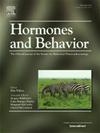Acute effects of estradiol on shoaling in male and female zebrafish (Danio rerio)
IF 2.4
3区 医学
Q2 BEHAVIORAL SCIENCES
引用次数: 0
Abstract
The role that estrogens play in the dynamic modulation of social behaviors related to reproduction has been well established, yet whether they can acutely modulate social responses outside of reproductive contexts remains less clear. Further, while estrogens typically promote aggressive responses in competitive contexts, especially in territorial species, it is possible they enhance non-sexual, prosocial interactions in other contexts, especially in species that live in groups. We therefore tested the acute effects of two doses of estradiol (E2) and of an aromatase inhibitor, Fadrozole, on social approach/preference responses for same-sex shoals in male and female zebrafish, as well as the effects of an agonist for the membrane G-protein coupled estrogen receptor (GPER). Estradiol, added to the water at a dose of 10–6 M, was able to significantly increase approach/preference responses in both sexes in multiple experiments in <1 h, whereas Fadrozole inhibited social approach responses 1 h and 17 h after exposure in females, but not in males. A GPER agonist did not enhance social preference responses like E2 did. Neither the effects of E2 nor FAD were paralleled by influences on measures of stress/anxiety, indicating E2 rapidly increases tendencies to approach and maintain proximity to groups in this highly social species through direct actions on social brain circuits.
雌二醇对雌雄斑马鱼浅游的急性影响
雌激素在与生殖相关的社会行为的动态调节中所起的作用已经得到了很好的证实,但它们是否能在生殖环境之外剧烈调节社会反应仍不清楚。此外,虽然雌激素通常在竞争环境中促进攻击性反应,特别是在领土物种中,但它们可能在其他环境中增强非性的、亲社会的相互作用,特别是在群居物种中。因此,我们测试了两种剂量的雌二醇(E2)和芳香酶抑制剂Fadrozole对雄性和雌性斑马鱼同性鱼群的社会接近/偏好反应的急性影响,以及膜g蛋白偶联雌激素受体(GPER)的激动剂的影响。在多个实验中,雌二醇以10-6 M的剂量加入水中,在1小时内能够显著增加两性的接近/偏好反应,而法唑在暴露后1小时和17小时抑制雌性的社会接近反应,但在雄性中没有。GPER激动剂不像E2那样增强社会偏好反应。E2和FAD对压力/焦虑测量的影响都不一致,这表明E2通过直接作用于社会脑回路,迅速增加了这种高度社会化物种接近并保持接近群体的倾向。
本文章由计算机程序翻译,如有差异,请以英文原文为准。
求助全文
约1分钟内获得全文
求助全文
来源期刊

Hormones and Behavior
医学-行为科学
CiteScore
6.70
自引率
8.60%
发文量
139
审稿时长
91 days
期刊介绍:
Hormones and Behavior publishes original research articles, reviews and special issues concerning hormone-brain-behavior relationships, broadly defined. The journal''s scope ranges from laboratory and field studies concerning neuroendocrine as well as endocrine mechanisms controlling the development or adult expression of behavior to studies concerning the environmental control and evolutionary significance of hormone-behavior relationships. The journal welcomes studies conducted on species ranging from invertebrates to mammals, including humans.
 求助内容:
求助内容: 应助结果提醒方式:
应助结果提醒方式:


